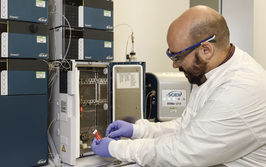
Lean, Mean Stability Machine
Demonstrating the stability of drug formulations over a range of times and environmental conditions is an essential aspect of drug development. But what exactly should be monitored – and how often?
Stephen Colgan, Senior Director in Global CMC at Pfizer Worldwide Research and Development is an advocate of lean stability testing, pointing out that the efficiency of stability testing can be greatly improved if we focus on the formulation’s weakest links. After all, why test the stability of a drug product when exposed to light when you already know from forced degradation studies that light will have no impact on the product’s stability or shelf life? And why take stability measurements at 3 and 6 months if you already know that the formulation is able to last at least one year? You are only creating more work for yourself, as well as for regulators, who have to assess all of the data. Lean stability strategies advocate that you only do what is scientifically relevant. Colgan tells us more – and why the industry is slowing taking steps to embrace the concept.
How did you get involved with lean stability at Pfizer?
I started out with a chemistry degree from a small State college in Cortland New York, before following it up with Masters in forensic chemistry and a PhD in chemistry, both from Northeastern University in Boston. My advisor recommended Pfizer because he knew of other students who were happy there and that Pfizer had a reputation of developing great scientists. I joined the company in 1987 – and I’ve been here ever since!
I started out in the analytical research and development department, spending 17 years there before moving into chemical R&D. I then moved to our supply chain group and about 10 years ago I joined the regulatory chemistry and manufacturing controls department. There I was asked if I wanted to focus on stability because no one else in the department was doing it at that time. I agreed – and it turned out to be a really interesting area. It’s very useful for a company to have people focusing on stability because it helps to improve the efficiency of both drug development and approval.
What is lean stability?
Drug product stability must be assessed under the influence of environmental factors and time, and ultimately form the basis for a product’s recommended storage conditions and shelf life. Simply put, lean stability emphasizes the important aspects of stability testing, and de-emphasizes the less important aspects. There are many attributes that are potentially relevant to product stability, such as dissolution, water content and degradation, among others. Lean stability is about using product understanding to identify and focus on the weakest links. Scientifically, one doesn’t need to measure all of the attributes that can affect product stability. If your weakest links for stability are fine, then the less vulnerable links will be fine too.
Lean stability also recognizes that every product is different. Rather than employing the one-size-fits-all approach that companies once brought to stability testing, a lean stability strategy will engineer a testing program specific to each product. In other words, it is about focusing on the most important aspects rather than just doing a box-checking exercise.
What are the main benefits?
Some people think that lean stability is a cost-savings measure, but in the short term it doesn’t save money at all. It’s more about focusing on the science and what is meaningful – this is beneficial for patients and industry because it helps create better medicines more efficiently. Products reach the market in a more efficient and timely manner because we’re not getting bogged down with monitoring things like water content, which almost always have no influence on patient safety or efficacy.
And the regulators benefit too because they can focus on meaningful data, which will give them greater confidence that there will be no unwelcome surprises once the medicine reaches patients in the real world.
How broadly is the concept used?
Lean stability is not a new concept. At Pfizer, we’ve been working on lean stability for more than a decade now, but lean stability was actually born in the early 90s when an ICH guidance was released that allows for bracketing and matrixing. ‘Bracketing’ refers to stability testing schedules in which only the extremes of design factors – such as strength or container size – are tested at all time points; and ‘matrixing’ means schedules that test only a subset of samples at a given time point – another subset is tested at a different time point.
So the concept of lean stability is broadly known, but the extent to which the techniques are used in practice often depends on the development phase. Some people are still quite uncomfortable with the concept. For people wanting to get into lean stability, a good place to start is to focus on early phase development and the active pharmaceutical ingredient (API). This is the area that most people are the most comfortable with when it comes to implementing lean stability, partly because you only have a few batches in early clinical development. In a Phase I trial, for example, there may be only one batch, which you can study extensively to accurately predict its stability.
In bigger trials, you need more batches and you also need to consider batch-to-batch variability. In addition, the stability programs used to support a new drug application (NDA) are the foundations for everything that follows – so people tend to be more conservative in later development, worrying that ‘going lean’ for the NDA may delay regulatory approval. Some companies also don’t want the increased regulatory questioning that you get when you introduce lean stability. At Pfizer, we’re comfortable with regulatory queries and our lean stability concepts for clinical trials are accepted by most regulators. Of course, each regulatory authority is different, and we’ve seen variability from country to country (and in some cases within the same agency) but that’s why I think that it is important to talk more about lean stability and to make more people in the industry aware of it.
How is lean stability implemented in practice?
In the pre-approval phases, you make multiple batches as you develop a product. The number of batches increases as the product advances. One key question you must ask is whether you need to test batch B, if batch A is already being tested. In this situation, you can determine the attributes that affect stability and once you know what you are looking for you can compare the data for batch A and B. If batch B attributes are consistent with the batch A attributes, there are no scientific drivers to set up batch B on stability – you can say that the stability of batch A is representative of batch B. Each step along the way, you conduct stability risk assessments and ask, has anything changed? If the answer is no, then you don’t need to set up new batches for stability testing. In the old days, we would set up just about everything for stability testing, but now we focus on what’s important. For example, does a stability risk assessment show that the product is unstable when exposed to light? If no, then you don’t need to worry about it.
Lean stability can also be applied in the post-approval stage. At this stage you will already have a tremendous amount of data about your product. For example, suppose that we wish to monitor the stability of the API. Often, we don’t need to assay the API itself because the weakest link may be formation of a specific degradant. The API assay would be a blunt measurement technique, whereas the degradation product would be a much more accurate indicator of stability. So for API stability, we often can justify monitoring the degradant (and not the assay). If the degradant is within specification, then we’ll know that the API assay will also be within specification. It’s always the weakest link that’s important. Many attributes actually have no impact on stability or shelf life. What you need to monitor varies depending on the product.
Any advice for implementing lean stability within a company?
Knowledge of both the product and process used to make the product is key. You also have to know the regulations and be able to work with those who may resist lean stability initiatives. You must be prepared to articulate and justify what you are doing – and then be prepared to go through the process again and again! My industrial colleagues often tell me that the highest hurdles they face are internal. Everyone likes progress, but no one seems to like change so be prepared for a lot of questions. But we should remember that many regulations are based on ICH guidance, and ICH states that alternative stability approaches can be used if scientifically justified, essentially allowing lean stability strategies, which can be helpful for countering internal resistance.
What lean stability developments would you like to see?
I’d like to see more – and better – stability models, because improved models will help advance not only lean stability, but also the industry as a whole. A tool called ASAP – the Accelerated Stability Assessment Program – has already been developed to help predict stability over time, and I think that the industry is becoming more comfortable with using these types of models. I’d also welcome an increase in the use of statistical measures in stability testing; I think it would resonate with the regulators if we can say that the chances of failing a specific specification at three years for example is very very low.
Finally, I also want to add that lean stability is an evolution, not a revolution. Lean stability is a strategy based on science and on what the regulators will allow, both of which will evolve over time.
At Pfizer, we are working with regulators in different countries to get lean stability concepts incorporated into their guidance. For example, we gave a workshop on lean stability for the regulators in Brazil in 2013, and another for the FDA in 2014. As guidances are updated, most agencies send them out for comments, and here at Pfizer we are working with other companies to coordinate our comments and to develop aligned positions that will benefit everyone. We all want new, safe and efficacious medicines – this is a common goal for industry and regulators – and I think that our interactions with the agencies, and the work we are doing with them on lean stability techniques, are steps towards that goal.
Sometimes people ask me, is all the effort worth it? My response is that people have to decide if they want to be doing their stability studies in 10 years’ time exactly the same way they are doing them today. If the answer is no, then they must move in the direction that the science indicates. And I believe that we are slowly moving in the right direction.
Stephen’s recommended publications:
S. T. Colgan et al., “Opportunities for Lean Stability Strategies,” J. Pharm. Innov. 9, 259–271 (2014).
S. Colgan et al., “Lean Stability,” AAPS Magazine, September (2015).



















